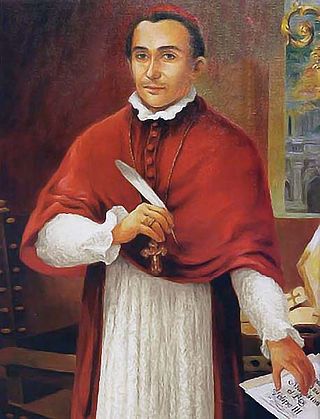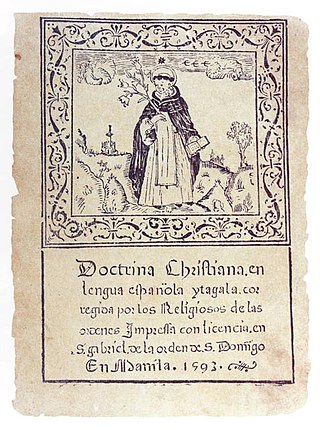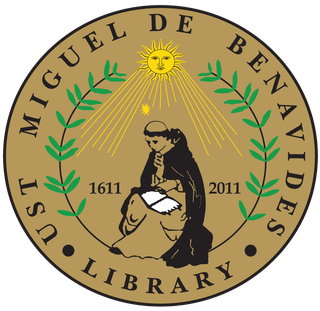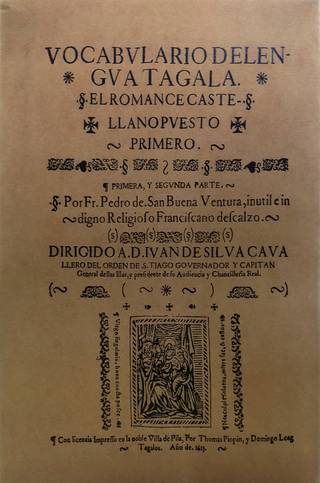Baybayin, also called Basahan and Guhit, erroneously known historically as alibata, is a Philippine script widely used primarily in Luzon during the 16th and 17th centuries to write Tagalog and to a lesser extent Kampampangan, Ilocano, and several other Philippine languages. An abugida belonging to the family of the Brahmic scripts, its use was gradually replaced by the Latin alphabet during the Spanish colonization, though it has since seen a limited modern usage in the Philippines. The script is encoded in Unicode as Tagalog block since 1998 alongside Buhid, Hanunoo, and Tagbanwa scripts. The Archives of the University of Santo Tomas in Manila holds the largest collection of extant writings using Baybayin.

The University of Santo Tomas, officially the Pontifical and Royal University of Santo Tomas, Manila or colloquially as Ustê, is a private, Catholic research university in Manila, Philippines. Founded on April 28, 1611, by Spanish friar Miguel de Benavides, third Archbishop of Manila, it has the oldest extant university charter in Asia and is one of the world's largest Catholic universities in terms of enrollment found on one campus. It is the main campus of the University of Santo Tomas System that is run by the Order of Preachers.

Philippine Hokkien is a dialect of the Hokkien language of the Southern Min branch of Min Chinese descended directly from Old Chinese of the Sinitic family, primarily spoken vernacularly by Chinese Filipinos in the Philippines, where it serves as the local Chinese lingua franca within the overseas Chinese community in the Philippines and acts as the heritage language of a majority of Chinese Filipinos. Despite currently acting mostly as an oral language, Hokkien as spoken in the Philippines did indeed historically have a written language and is actually one of the earliest sources for written Hokkien using both Chinese characters as early as around 1587 or 1593 through the Doctrina Christiana en letra y lengua china and using the Latin script as early as the 1590s in the Boxer Codex and was actually the earliest to systematically romanize the Hokkien language throughout the 1600s in the Hokkien-Spanish works of the Spanish friars especially by the Dominican Order, such as in the Dictionario Hispanico Sinicum (1626-1642) and the Arte de la Lengua Chiõ Chiu (1620) among others. The use of Hokkien in the Philippines was historically influenced by Philippine Spanish, Filipino (Tagalog) and Philippine English. As a lingua franca of the overseas Chinese community in the Philippines, the minority of Chinese Filipinos of Cantonese and Taishanese descent also uses Philippine Hokkien for business purposes due to its status as "the Chinoy business language" [sic]. It is also used as a liturgical language as one of the languages that Protestant Chinese Filipino churches typically minister in with their church service, which they sometimes also minister to students in Chinese Filipino schools that they also usually operate. It is also a liturgical language primarily used by Chinese Buddhist, Taoist, and Matsu veneration temples in the Philippines, especially in their sutra chanting services and temple sermons by monastics.
Philippine literature in Spanish is a body of literature made by Filipino writers in the Spanish language. Today, this corpus is the third largest in the whole corpus of Philippine literature. It is slightly larger than the Philippine literature in the vernacular languages. However, because of the very few additions to it in the past 30 years, it is expected that the former will soon overtake its rank.
The Royal University Militias were eighteenth-century Spanish colonial military units in the Philippines.

The University of Santo Tomas is one of the oldest existing universities and holds the oldest extant university charter in the Philippines and in Asia. It was founded on April 28, 1611, by the third Archbishop of Manila, Miguel de Benavides, together with Domingo de Nieva and Bernardo de Santa Catalina. It was originally conceived as a school to prepare young men for the priesthood. Located Intramuros, it was first called Colegio de Nuestra Señora del Santísimo Rosario and later renamed Colegio de Santo Tomás in memory of Dominican theologian Saint Thomas Aquinas. In 1624, the colegio was authorized to confer academic degrees in theology, philosophy, and arts. On November 20, 1645, after representations by Vittorio Riccio, Pope Innocent X elevated the college to the rank of a university and in 1680 it was placed under royal patronage.
The Pontifical and Royal University of Santo Tomas (UST) Quadricentennial Celebration took place from December 18, 2009 to January 27, 2012. The agenda before the quadricentennial year in 2011 included the introduction of new academic programs, improvements in the university's infrastructure, and other projects to raise UST's national and international prominence and promote its role as a social catalyst.

Miguel de Benavides y Añoza, O.P. was a Spanish Catholic prelate and sinologist who served as the third Archbishop of Manila. He previously served as the first Bishop of Nueva Segovia and was the founder of the University of Santo Tomas in Manila.
Juan Cobo OP was Spanish Dominican missionary, diplomat, astronomer and sinologist.

During the Spanish colonial period in the Philippines (1521–1898), the different cultures of the archipelago experienced a gradual unification from a variety of native Asian and Islamic customs and traditions, including animist religious practices, to what is known today as Filipino culture, a unique hybrid of Southeast Asian and Western culture, namely Spanish, including the Spanish language and the Catholic faith.
Tomás Pinpin was a printer, writer and publisher from Abucay, a municipality in the province of Bataan, Philippines, who was the first Philippine printer and is sometimes referred as the "Prince of the Filipino Printers."

The Doctrina Christiana were two early books on the catechism of the Catholic Church, both published 1593 in Manila, Philippines. These are two of the earliest printed books in the Philippines.

The Miguel de Benavides Library, also known as the University of Santo Tomas Library, is the main academic library of the University of Santo Tomas. The library has been in continuous service and its collection antedates the existence of the university itself.
Fidel Villarroel was a Spanish historian, writer, filipinologist, biographer, political commentator, Master Theologian of the Dominican Order, and member of the Order of Isabella the Catholic. A recipient of the Pro Ecclesia et Pontifice, he is the former Archivist, Spanish Department Director, Prefect of Libraries, and professor at the Pontifical and Royal University of Santo Tomas. He had also served as secretary to the Apostolic Nunciature for 32 years(1959–1991), and is currently an academic director of the prestigious Academia Filipina de la Lengua Española, the local branch of the renowned Real Academia Española based in Madrid, Spain, and part of the Asociación de Academias de la Lengua Española.
This is a timeline of the history of the Pontifical and Royal University of Santo Tomas, the oldest university in Asia, comprising important events of the history of the university and of the development of Philippine higher education in general. To read about the background to these events, see History of the University of Santo Tomas. See also the history of the Rector Magnificus of the University of Santo Tomas, and the Santo Tomas Internment Camp

The Archives of the University of Santo Tomas (AUST), also known in Spanish as the Archivo de la Universidad de Santo Tomas, is located at the Miguel de Benavides Library in Manila. The AUST is the central repository of historical and rare documents pertaining to, but not exclusively, to the history of the University of Santo Tomas, one of the oldest existing universities in Asia, and the oldest institution of higher learning in the Philippines. The collections consist of historical documents such as Papal bulls, royal decrees, rare Filipiniana prints, historical treatises, addresses, sermons, novenas, catechisms in many Philippine languages, national periodicals, and academic records of all educational institutions in the Philippines during the Spanish period. The archives is also home to the only incunabula, or books printed before 1500, in the country.

Vocabulario de la lengua tagala was the first dictionary of the Tagalog language in the Philippines, It was written by the Franciscan friar Pedro de San Buena Ventura and published in Pila, Laguna, in 1613. Juan de Plasencia had written a vocabulario earlier but it was not printed. More than a century later, a dictionary of the same name was prepared by Jesuit priests Juan de Noceda and Pedro de Sanlucar; their first edition was published in Manila in 1754 and then the second in 1860, which was reissued by the Komisyon sa Wikang Filipino in 2013.

Saint Dominic de Guzman Parish Church, commonly known as Abucay Church, is a 17th-century Baroque Roman Catholic church located at Brgy. Laon, Abucay, Bataan, Philippines. The parish church, established in 1587 and administered by the Dominican Missionary Friars in 1588, is dedicated to Saint Dominic of Guzman. The parish is under the jurisdiction of the Diocese of Balanga. Since June 5, 2023, its parish priest is Fr. Milver R. Cruz.
Francisco Blancas de San José played a prominent role in the history of printing and publishing in the Philippines during the late 18th century, contributing to the development of these practices in the region.











